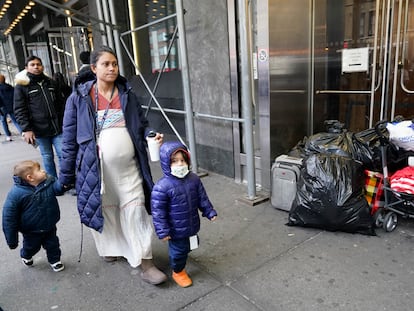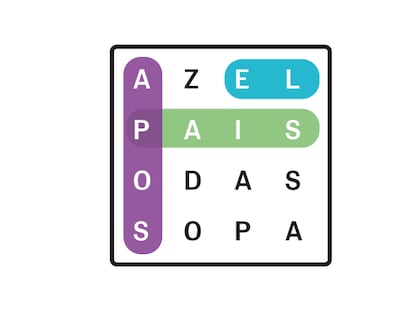The safest and most at-risk states for immigrants: A map of U.S. immigration laws
From California to Florida, the majority of states have anti-immigrant legal frameworks. However, about 20 of them lack laws regulating the issue
Since Donald Trump’s return to the White House, the country’s immigration authorities have been busy pursuing and rounding up undocumented immigrants. According to official figures, more than 142,000 people were deported in the first 100 days of the Trump administration. “It’s just the beginning,” they have warned, but the authorities’ actions have not been without obstacles.
While the IRS and the Postal Service have decided to collaborate in recent weeks by providing information on undocumented immigrants, the push for the Republican’s immigration agenda has been halted by court action and the refusal of sanctuary cities to participate with their police forces in mass raids. The Department of Homeland Security has responded with a vigorous campaign to encourage self-deportation, and Trump is offering up to $1,000 as an incentive to all those who do so. The success of the president’s plans remains in the hands of the states, their domestic law enforcement and criminal justice systems, and their willingness or lack thereof to cooperate with federal agencies in the task of hunting down and deporting undocumented immigrants.
Some Republican-leaning states have aggressively pursued this goal with their own legislation. The Texas Senate, for example, approved a bill in early April that will require sheriffs in all counties with more than 100,000 residents to sign cooperation agreements with U.S. Immigration and Customs Enforcement (ICE). Florida has also followed suit with the enactment of a new law on the matter, which experts have quickly described as the most severe in the country. Last year, Iowa, Louisiana, and Oklahoma also worked to create state mechanisms for deportation and crimes related to undocumented immigrants, although several of these laws have been blocked by federal courts.
For their part, Democratic strongholds, with some state laws protecting immigrants, now represent a bulwark against a federal administration determined to carry out the largest deportation in history. Only Oregon and Illinois have comprehensive laws restricting the transfer of people to ICE detention centers; but other states have substantial limitations to prevent the arrest of this population.
Despite the anti-immigrant climate that has gripped the country, more foreigners live in states with protective laws (23 million people) than in those with harmful laws (15 million people). Thus, 17 million immigrants live in regions that have not passed any laws enforcing federal immigration laws. These data come from the Immigrant Resource Legal Center (IRLC), the organization that since 1979 has worked to improve immigration legislation and policy in the United States by training lawyers, paralegals, and community advocates and promoting immigrant rights.
The institution also provides the most up-to-date map of states with local legislation limiting or expanding the application of federal immigration laws: which territories have taken significant steps in creating a legal framework that protects their migrant communities, which have done nothing, which have prevented their localities from taking protective measures, and which have passed laws attempting to force local law enforcement to become an arm of the federal detention and deportation system.
In this regard, the map included in this article analyzes the immigration laws of the 50 states and the District of Columbia based on 20 parameters, divided into five categories: information and resource sharing with ICE, jail transfers to ICE, patrol agent collaboration with ICE, contracts with ICE or Customs and Border Protection, and state laws that criminalize immigration. States received a numerical score from one to five for each parameter, with one being the most harmful and five being the most protective.
The states with the most protective laws
Two states have the strongest laws protecting immigrants: Oregon (4.3) and Illinois (4.3). Three others also have fairly broad sanctuary statutes: California (3.95), New Jersey (4.05), and Washington (4.05).
In these territories, local law enforcement is not involved in deportations, and immigrant communities are generally better integrated. Their children are less likely to live in fear of losing a parent to deportation, access to justice is protected, and crime rates are declining, according to research by the Immigrant Legal Resource Center. When ICE carried out its first raid in Chicago, one of the largest sanctuary cities in the country, last January, the state’s Democratic authorities refused to participate in the operation.
States with immigration-friendly laws
There are four: Colorado (3.35), Connecticut (3.5), Maryland (3.25), and Vermont (3.55). All have enacted protections for immigrants and against the enforcement of federal immigration laws.
States that are moderately protective of immigration
New York (3.1) and Rhode Island (3.1) fall into this category. Both have taken steps to reduce immigration enforcement. However, New York City Mayor Eric Adams has expressed support for Trump’s plans in exchange for help with his legal problems (the official is accused of corruption), leading to a historic shift in the city’s immigration policy.
States collaborating with ICE
They are Arizona (2.65), Arkansas (2.7), Idaho (2.7), Indiana (2.75), Kansas (2.8), Louisiana (2.45), Mississippi (2.95), Missouri (2.95), Montana (2.9), North Carolina (2.85), North Dakota (2.95), Oklahoma (2.9), and South Carolina (2.65). These territories have enacted laws requiring local agencies to participate to some extent in immigration enforcement, furthering Trump’s immigration agenda.
States with anti-sanctuary laws
Alabama (2.4) and Tennessee (2.55) fall behind here. Two states with sweeping anti-sanctuary laws and significant negative effects on their immigrant residents.
The states with the most harmful immigration laws
Five states have the most aggressive anti-sanctuary laws in the country, requiring local agencies to become significantly involved in the deportation of undocumented residents: Florida (1.95), Georgia (2.55), Iowa (2.05), Texas (1.95), and West Virginia (2.4). Although several of these laws have been severely limited by federal court decisions, many of their implications remain.
The Immigrant Legal Resource Center report notes that “local involvement in immigration enforcement turns local agencies into gateways to deportation, co-opts local resources for questionable and discriminatory purposes, strips communities of any sense of security, and undermines the rule of law.”
States without legislation on the matter
These are Alaska, Hawaii, Nevada, Utah, New Mexico, Wyoming, South Dakota, Nebraska, Minnesota, Wisconsin, Michigan, Ohio, Kentucky, Pennsylvania, Virginia, Delaware, Massachusetts, New Hampshire, and Maine. All have a score of 3.
These territories, which have not enacted any immigration enforcement laws, nevertheless provide “unnecessary, sometimes illegal and unconstitutional, assistance to ICE,” the Immigrant Legal Resource Center asserts.
Sign up for our weekly newsletter to get more English-language news coverage from EL PAÍS USA Edition
Tu suscripción se está usando en otro dispositivo
¿Quieres añadir otro usuario a tu suscripción?
Si continúas leyendo en este dispositivo, no se podrá leer en el otro.
FlechaTu suscripción se está usando en otro dispositivo y solo puedes acceder a EL PAÍS desde un dispositivo a la vez.
Si quieres compartir tu cuenta, cambia tu suscripción a la modalidad Premium, así podrás añadir otro usuario. Cada uno accederá con su propia cuenta de email, lo que os permitirá personalizar vuestra experiencia en EL PAÍS.
¿Tienes una suscripción de empresa? Accede aquí para contratar más cuentas.
En el caso de no saber quién está usando tu cuenta, te recomendamos cambiar tu contraseña aquí.
Si decides continuar compartiendo tu cuenta, este mensaje se mostrará en tu dispositivo y en el de la otra persona que está usando tu cuenta de forma indefinida, afectando a tu experiencia de lectura. Puedes consultar aquí los términos y condiciones de la suscripción digital.
More information
Archived In
Últimas noticias
Most viewed
- Oona Chaplin: ‘I told James Cameron that I was living in a treehouse and starting a permaculture project with a friend’
- Reinhard Genzel, Nobel laureate in physics: ‘One-minute videos will never give you the truth’
- Sinaloa Cartel war is taking its toll on Los Chapitos
- Why the price of coffee has skyrocketed: from Brazilian plantations to specialty coffee houses
- Chevy Chase, the beloved comedian who was a monster off camera: ‘Not everyone hated him, just the people who’ve worked with him’











































